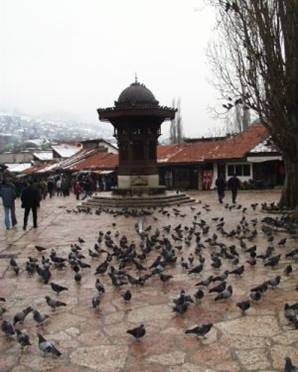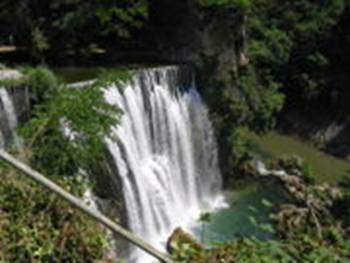BOSNIA & HERZEGOVINA
OVERVIEW: Day 1: Arrival Sarajevo
|
Detailed Itinerary
Day 1: Arrival Sarajevo, Bosnia
Upon arrival to Sarajevo airport you will be met by our representative and transfer to your hotel.
Overnight in Sarajevo – Hotel Astra Garni 3*
Day 2: Sarajevo – Medjugorje - Mostar
 We will start our day by enjoying a walking city tour of Sarajevo. This magical town with all its charms will take you instantly back to Ottoman times. Here we will visit beautiful Ottoman mosques, the old quarters and the authentic Turkish “carsija”, with its oriental sweets shops, cafes and traditional Bosnian food. Sarajevo is also a town in which for more then 400 years mosques, orthodox churches, roman-catholic churches and synagogues have been standing together.
We will start our day by enjoying a walking city tour of Sarajevo. This magical town with all its charms will take you instantly back to Ottoman times. Here we will visit beautiful Ottoman mosques, the old quarters and the authentic Turkish “carsija”, with its oriental sweets shops, cafes and traditional Bosnian food. Sarajevo is also a town in which for more then 400 years mosques, orthodox churches, roman-catholic churches and synagogues have been standing together.
A breathtaking drive along river Neretva and through the Bosnian Mountains will take us to a small village which is a target of many pilgrims from all around the world in the last 24 years. In 1981, several of the local children received the message of Virgin Mary, and since then, this has been a place of miracles, which draws many believers. We will visit the local church and the area where the miracle supposedly happened.
Mostar is a very picturesque town, more then 5 centuries old and made famous by the old Turkish bridge that once was the only means uniting the city over the emerald waters of the Neretva River. The bridge always played a central role in lives of its inhabitants.
The original bridge was wooden, built at the beginning of the 15th century, and it was a very important link between the two parts of Herzegovina, not only strategically but also in respect of trade linking the sea to the interior. This soon brought the urgent need to replace the old unsafe wooden chain bridge with a new which could meet the growing requirements. The construction began in 1557 and continued for nine years. The bridge is the masterpiece of Hajrudin, a pupil of the famous builder Sinan. The year of the completion was 1566.
Tall and white, with its graceful arch, it appears to be cut from the single huge stone slab. It is 13.5 feet wide and 60ft high and its stone arch is slightly less then 90ft long.
We will enjoy the lively atmosphere of the old bazaar around it and admire medieval Turkish architecture.
Overnight in Mostar – Hotel Ero 4* (B)
Day 3: Mostar - Jajce - Banja Luka
We will start our day by driving through the beautiful and wild Bosnian Mountains, deep into the very heart for the country. We will pay a visit to the small town of Jajce, located on the confluence of rivers Pliva and Vrbas. The town was built in the 14th century and was a capital of the Bosnian kingdom at that time. It has gates and fortifications, as well as a castle which has walls which lead to the various gates around the town. When the Bosnian kingdom fell to the Ottoman Empire in 1463, Jajce was taken.
During WWII, Jajce hosted the second convention of the Anti-Fascist Council of Yugoslavia, a meeting that set the foundation for the Socialist Federal Republic of Yugoslavia.
 The town is famous for its beautiful waterfall at the place where the lake Pliva meets the river Vrbas. The waterfall was 30 meters high, but, due to some earthquakes and floods, the level of the ground changed, now leaving a waterfall 20 m high.
The town is famous for its beautiful waterfall at the place where the lake Pliva meets the river Vrbas. The waterfall was 30 meters high, but, due to some earthquakes and floods, the level of the ground changed, now leaving a waterfall 20 m high.
In the afternoon we will arrive to Banja Luka, the second largest town in Bosnia & Herzegovina. The town lies on the river Vrbas, surrounded by hills.
The name "Banja Luka" was first mentioned in a document dated 1494, but Banja Luka's history dates back to ancient times. There is substantial evidence of a Roman presence in the region during the first few centuries AD, including an old fort "Kastel" in the center of the city. The area of Banja Luka was in the Roman province of Illyricum, lying on the important road between Dalmatia and Panonia.
The city underwent considerable changes during the Yugoslav wars. Upon the declaration of the establishment of Republika Srpska, Banja Luka became the de facto center of the entity's politics, and in 2003 it officially became the capital of Republika Srpska.
Overnight in Banja Luka - Hotel Bosna “B” (B)
Day 4: Banja Luka departure
After breakfast there will be a transfer to the airport for your flight
B - Breakfast L – Lunch D – Dinner
All hotels are carefully chosen for their character or best central location or they are simply the only option at certain destinations. All of them can be changed on a request. The categories mentioned by the hotel names are according to the local standards and sometimes do not reflect to Western standards
Trip organized by: “BALKAN EXPERT” d.o.o. license no. OTP 54/2013
Tour available with general condition of travel of “BALKAN EXPERT”






